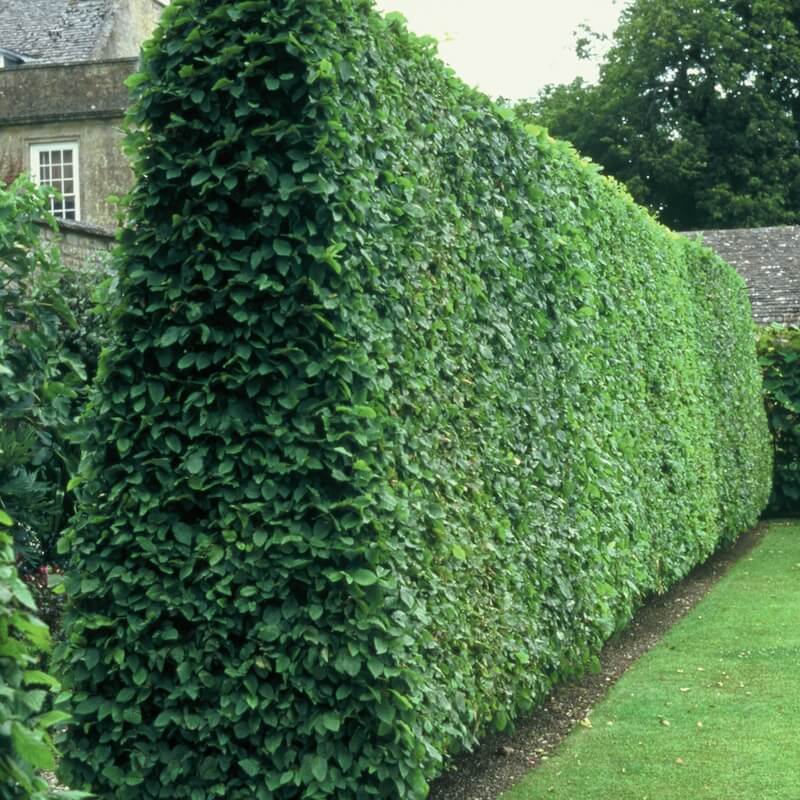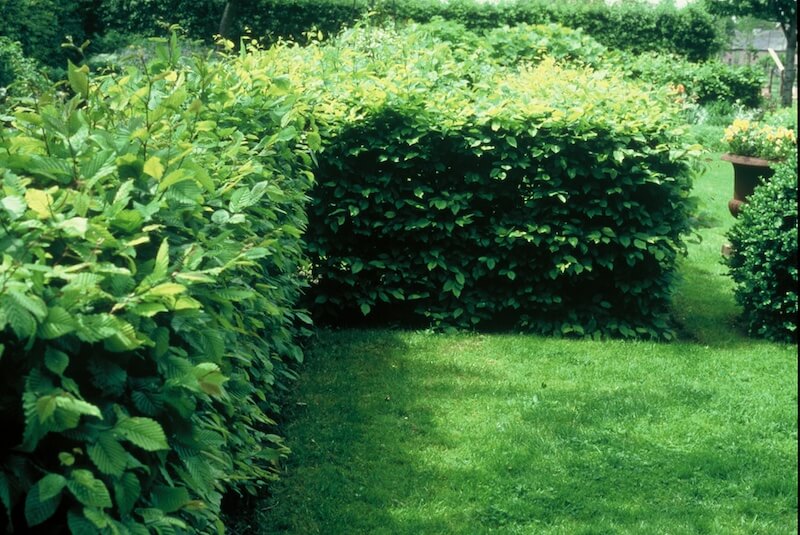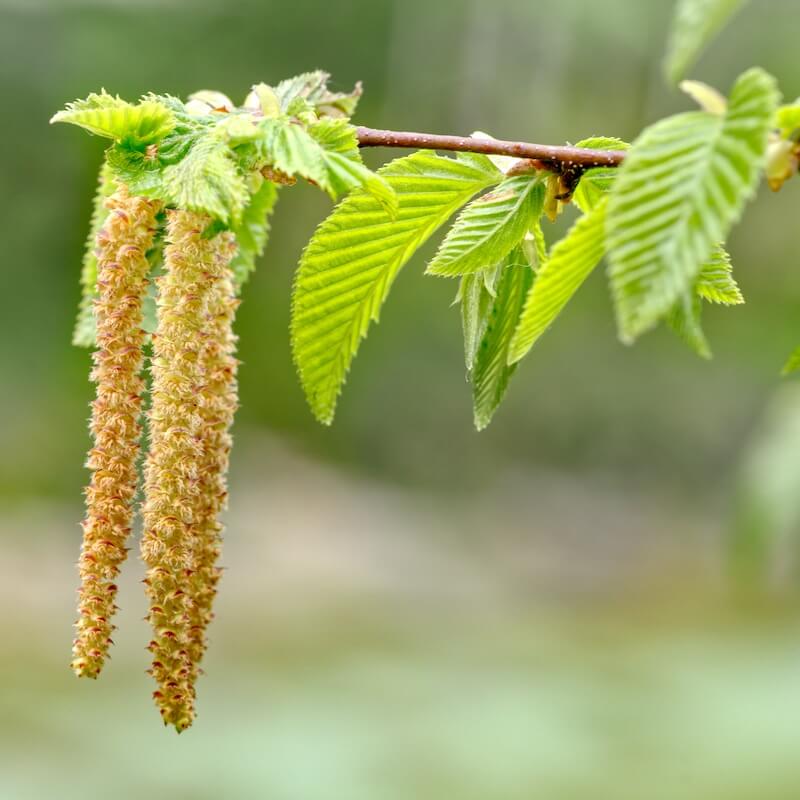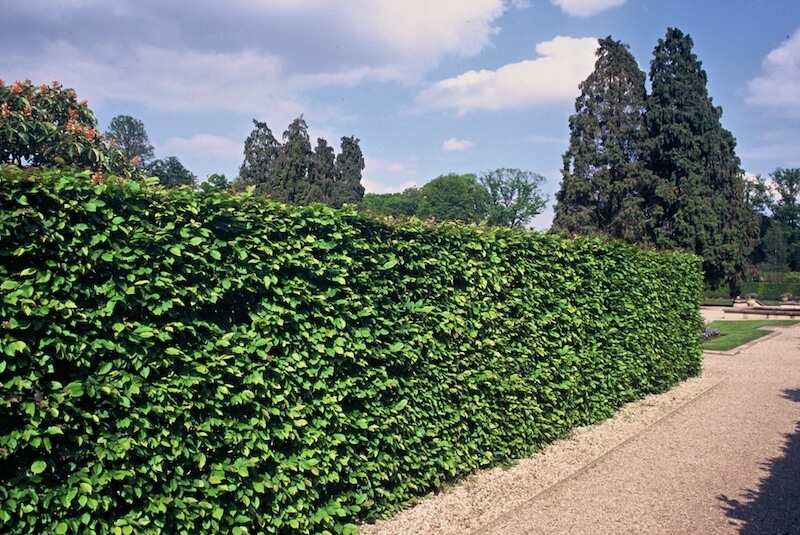Carpinus betulus - The Elegant Hedge for All Seasons
common hornbeam, charmille, European hornbeam, horn beech, horse beech, hurst beech, white beech, yoke elm, oestrywydden, Carpinus caucasia, Carpinus vulgaris, Carpinus caucasica

Position
- Thrives in full sun to light shade
- Ideal as a specimen tree, formal hedge or pleached screen
- Tolerant of urban conditions and sheltered or exposed sites
Hardiness
- Withstands winter lows down to around -30°C (-22°F)
- Reliable across the UK; a mulch helps young trees in very exposed spots
Soil
- Adapts to a wide range: clay, loam, chalk or sandy soils
- Performs best in fertile, well-drained ground improved with compost
- Avoids prolonged waterlogging—ensure free drainage at the roots
- Tolerates acid, neutral or alkaline soils
- Most vigorous where organic matter maintains soil structure and moisture
- Grab a soil test kit and ensure the perfect conditions for growth
Height
- Typically 3–6 m (10–20 ft) tall after 5–10 years, depending on site and management
Seasons of Interest
Additional Notes
- Responds well to clipping or pollarding—ideal for formal hedges and pleached alleys
- Root-ball benefits from mulch in the first few years to retain moisture and suppress weeds
- Drought-tolerant once established, but prefers regular watering in dry spells
- Supports wildlife: pollen for early insects and seed for birds
- Very long-lived and low maintenance; occasional formative pruning shapes young trees
Carpinus betulus - A Versatile and Hardy Hedge Choice
Carpinus betulus, more widely known as the hornbeam, is a strong, adaptable, and attractive choice for gardeners across the UK. This large deciduous tree offers beauty, structure, and seasonal interest, making it a reliable pick for hedge planting whether you want a formal boundary, a wildlife-friendly screen, or a classic avenue, a hornbeam hedge delivers lasting impact.
What Makes Carpinus betulus a Great Choice for Your Hedge?
Carpinus betulus, also called the common hornbeam, is known as the European hornbeam in some regions. This deciduous tree grows well in varied conditions, with a growth rate of 30–60cm per year in good soil. It features dense foliage, which creates excellent privacy, and leaves that turn yellow in autumn for vibrant seasonal interest.
Unlike many hedge plants, the hornbeam holds its leaves in winter, giving year-round screening. Although technically deciduous, its retained foliage makes it a strong alternative to evergreen hedges. This feature means your garden enjoys both summer and autumn colour while staying protected from winter winds.
The tree’s fluted grey trunk and ovate leaves with serrate edges add to its visual charm. Many gardeners choose it for its award of garden merit from the Royal Horticultural Society, recognising its versatility and reliability.
How to Identify the Hornbeam and Its Key Features
The hornbeam’s leaves are mid-green in spring and summer, with prominent veins and a rib-like structure. In autumn, they turn a golden-yellow before falling, often staying on the branches through winter. Its foliage is serrate-edged and ovate, giving it a textured, attractive appearance.
Hornbeam catkins appear in late spring. Male catkins are slender, while female catkins develop into hop-like fruiting catkins by late summer. The fluted grey trunk is another distinguishing feature, along with the tree’s upright form when young. Twigs are slender and flexible, supporting healthy new growth each year.
Hornbeam timber is dense and durable, traditionally used for firewood, furniture, and even crafting a flute. As a woodland tree, it grows naturally across continental Europe, western Asia, and parts of southern England.

Understanding the Common Hornbeam’s Seasonal Interest
Carpinus betulus offers exceptional seasonal interest. In spring and summer, the foliage is lush and mid-green, providing cooling shade. In late spring, catkins appear, followed by hop-like fruiting catkins in late summer.
By autumn, the leaves are turning yellow, creating a warm glow in the garden. Many leaves remain attached in winter, giving privacy and protection when other deciduous plants are bare. This means a hornbeam hedge looks structured and purposeful in every season.
Seasonal interest also extends to its bark. The fluted grey trunk adds character in winter, especially when frost catches the grooves. For year-round appeal, few hedge plants match the hornbeam.
Where Does the Hornbeam Grow Best?
Hornbeam grows well across most of the UK, including southern England. It tolerates clay and chalk soils, provided they are well-drained. The root system prefers moisture and nutrients without waterlogging, which can cause root rot.
In its native habitat, the hornbeam thrives as a woodland tree, often found in mixed forests alongside beech. It can handle cooler winters down to -30°C (-22°F) and warm summers up to 30°C (86°F). These conditions make it an adaptable choice for a wide range of garden locations.
For urban gardens, hornbeam tolerates pollution and wind well, making it a practical hedge plant even in exposed spots.
Soil Preparation Tips for Healthy Carpinus betulus Growth
Hornbeam needs well-drained soil for healthy growth, but it’s tolerant of most soil types. Before planting, test soil fertility and improve it with organic matter if needed. Avoid sites with prolonged waterlogging, as this can lead to root rot.
If you’re planting in clay soils, mix in grit or sand to improve drainage. For sandy soils, add compost to help retain moisture and nutrients. Carpinus betulus has a fibrous root system that benefits from a well-prepared planting trench.
A planting density of 3–5 plants per metre is ideal for a thick hedge. For a specimen tree, allow more space around the tree for its natural spread.
How to Prune Carpinus betulus to Keep It in Shape
Prune once a year in late summer to maintain a neat hedge. This timing encourages the hedge to hold its leaves all year round, improving winter coverage. For formal hedges, trim the sides slightly narrower at the top to let light reach the lower branches.
If growing as a tree, you can pollard or coppice hornbeam to manage size. It responds well to hard pruning, even from old wood. For topiary shapes, trim regularly during the growing season.
Regular pruning keeps the hedge dense and encourages new growth, preventing gaps from forming.
Recognising Hornbeam Catkins in Late Spring
Hornbeam flowers emerge in the form of delicate catkins during late spring, adding subtle seasonal interest to this versatile tree. The male catkins are typically long, pendulous, and softly swaying in the breeze, while the female catkins are shorter and more compact in form. As the growing season progresses, the female catkins gradually transform by late summer into clusters of papery, pale green bracts, followed by distinctive hop-like fruiting catkins that remain on the branches well into autumn, providing texture and charm even as the leaves begin turning yellow.
Gardeners often observe that the first catkins appear just as the fresh, mid-green leaves have fully unfurled, marking the transition into the tree’s most active period of healthy growth. This harmonious blend of spring catkins, lush summer foliage, and persistent autumnal features contributes to the hornbeam’s enduring appeal as a reliable, low-maintenance choice for hedges, topiary, or as a standalone specimen in the garden.

Carpinus betulus vs Beech - Which Hedge Plant is Right for You?
Both hornbeam and beech are popular hedge plants. Beech prefers lighter, well-drained soils, while hornbeam grows well in heavier clay soils. Hornbeam is more tolerant of wet conditions and can handle exposed sites better.
Beech leaves turn copper in autumn and remain on the branches through winter. Hornbeam leaves turn yellow in autumn, often staying attached to provide screening. The choice depends on your soil type, local climate, and personal preference.
If you live in cooler, wetter areas, hornbeam is generally the better option.
Where to Buy Carpinus betulus and What to Look For
You can buy Carpinus betulus from nurseries, garden centres, or online suppliers. Look for healthy plants with a strong root system and no signs of disease. Bare-root plants are cost-effective for large hedge projects, while potted plants allow flexible planting times.
When buying, consider the maximum height you want and choose plants accordingly. For a tall hedge, opt for young trees that can grow together over time. For instant impact, buy more mature specimens, though these cost more.
Always source from reputable suppliers to ensure quality and avoid pests or diseases.

From Darren’s Patch
There’s something wonderfully dependable about a hornbeam hedge. Mine stands as a steadfast green wall beside a neighbouring field, offering shelter from the wind and a changing backdrop through the seasons. I value its ability to hold its leaves well into winter, giving privacy when the rest of the garden feels bare. In spring, the fresh green foliage is uplifting, and by autumn, its golden tones bring warmth to the landscape. It’s also forgiving — tolerant of varied soils and happy in both sun and partial shade — which makes it a safe choice for many gardens. Whether you want a formal screen, a wildlife-friendly boundary, or simply a hedge that looks good year-round with minimal fuss, Carpinus betulus delivers. For me, it’s a plant that quietly works hard in the background, but the garden wouldn’t feel complete without it.
![]()
Key Points to Remember
- Carpinus betulus is a versatile hedge plant for UK gardens
- Holds many leaves in winter, offering privacy all year
- Tolerates clay and chalk soils if well drained
- Plant in autumn or spring for best root establishment
- Prune once a year in late summer to keep shape and coverage
- Offers seasonal interest with yellow autumn foliage and spring catkins
- Ideal for formal, wildlife-friendly, or topiary hedges
- Available as bare-root or container-grown plants
- More tolerant of wet soils than beech
- Awarded the RHS Award of Garden Merit for reliability
Carpinus betulus prospers in sun or light shade on most soils (acid to alkaline), improved for fertility and drainage, enduring down to -30°C (-22°F). In 5–10 years, it reaches 3–6 m (10–20 ft), offers spring catkins, summer foliage, golden autumn colour and winter structure, and is superb for hedges, screens or specimen planting with low ongoing care.
Want to learn about other ornamental tree varieties? Read about Acer campestre here.
For more information on Ornamental Trees for your garden, please click here.
Frequently Asked Questions
Q: What is Carpinus betulus?
A: Carpinus betulus, known as hornbeam or common hornbeam, is a large deciduous tree native to continental Europe and western Asia. This upright tree is valued as a hedge plant and for its dense foliage, which turns yellow in autumn, creating seasonal interest. Its ovate leaves have prominent veins and serrate edges, remaining on the plant as brown leaves in winter, offering screening when other deciduous species are bare. In late spring, catkins appear, followed by hop-like fruiting catkins. Hornbeam timber is hard and durable, making good firewood. Its fluted grey trunk and attractive foliage make it a standout woodland tree or formal hedge choice.
Q: When is the best time to plant a hornbeam hedge?
A: The best time to plant a hornbeam hedge is in autumn or early spring, during the dormant season, when the root system can establish before active growth. Carpinus betulus grows well in well-drained soil, even on clay and chalk, provided there is low clay content to avoid waterlogging and root rot. Bare-root hedge plants are ideal for planting at this time, with a planting density of around five plants per metre for a dense hedge. This species retains leaves in winter, giving year-round screening. Trim once a year in late summer to maintain shape and encourage healthy growth.
Q: How should I care for a hornbeam hedge?
A: A hornbeam hedge benefits from regular pruning to maintain density and form. Trim once a year in late summer, after the growing season, to encourage new growth and a tidy shape. In spring, apply a balanced feed to support soil fertility and healthy growth. Keep the area around the tree or hedge free from weeds, which compete for moisture and nutrients. Water newly planted hedge plants well in dry spells during spring and summer. Hornbeam is hardy, tolerant of clay and chalk soils, and grows well in both full sun and partial shade, making it a versatile choice for UK gardens.
Q: What do the flowers of Carpinus betulus look like?
A: In late spring, catkins appear on Carpinus betulus, providing subtle seasonal interest. Male catkins are long and pendulous, while female catkins are smaller and upright, later developing into hop-like fruiting catkins. These decorative seed structures persist into summer and autumn, adding texture to the hedge or tree. The understated flowers complement the plant’s mid-green foliage, which turns yellow in autumn, creating a refined and natural look in both formal and informal garden settings.
Q: How fast does a common hornbeam grow?
A: Carpinus betulus has a moderate to fast growth rate, making it an excellent hedge choice for those seeking structure without excessive maintenance. Under good growing conditions with well-drained soil and adequate moisture and nutrients, it can grow 30–60cm per year. A hornbeam hedge will typically reach a maximum height of 4–5 metres if left untrimmed, though it can be maintained lower for formal hedging. This species is tolerant of pruning and can be coppiced and pollarded, making it ideal for topiary or as a managed hedge. It also withstands exposed sites and the climate of southern England well.
Q: Where can I buy Carpinus betulus?
A: You can buy Carpinus betulus hedge plants from garden centres and reputable online plant retailers across the UK. Bare-root hedge plants are usually available from autumn to early spring, while potted specimens can be purchased year-round. When sourcing plants, look for healthy, well-rooted specimens to ensure strong establishment. For larger projects, many horticultural suppliers offer bulk discounts on hedge plants. Choosing a trusted supplier ensures you receive plants that will establish well, giving you a vigorous and attractive hornbeam hedge that provides structure, seasonal interest, and screening for many years to come.
